Leather Coral 101: Care, Appearance & Types, Placement & More
Posted by on 01/19/2023
Fact checked by
We use affiliate links and may receive a small commission on purchases.
Leather corals may not be as popular as some of the other corals in the reef keeping hobby, but that does not diminish their appeal. While coral preferences vary from person to person, certain leather coral species are more prevalent than others.
If you’re interested in adding a leather coral to your reef aquarium, you’ll want to be aware of the unique characteristics of these types of corals. In this post, we will cover everything you need to know about caring for leather corals, including the most popular species, placement, growth rate, and more.
Species Summary
Leather corals are typically soft corals that are descendants of the Alcyoniidae family of corals, and the ones seen most frequently in the reef keeping hobby are members of the Sarcophyton Genus. Many of the corals of this genus were first scientifically documented by French surgeon, naturalist, and herpetologist René Lesson in 1834, and these corals have been captivating the minds of reef enthusiasts ever since.
Over 50 species have been documented under the Sarcophyton genus, and they can be found globally throughout the world's temperate and tropical seas, where they’re commonly found in the tranquil waters of lagoons.
These corals have a stable population and face little predation. Their peaceful existence is enhanced by their symbiotic relationship with zooxanthellae, a relationship shared with other corals, such as chalices.
Leather corals are stiff and inflexible and are named after their "leathery" tissue, which is composed of tiny polyps that can take the form of large trunks or tiny branched tentacles. Two types of polyps exist in leather corals, autozooids and siphonozooids, and their size varies depending on the species.
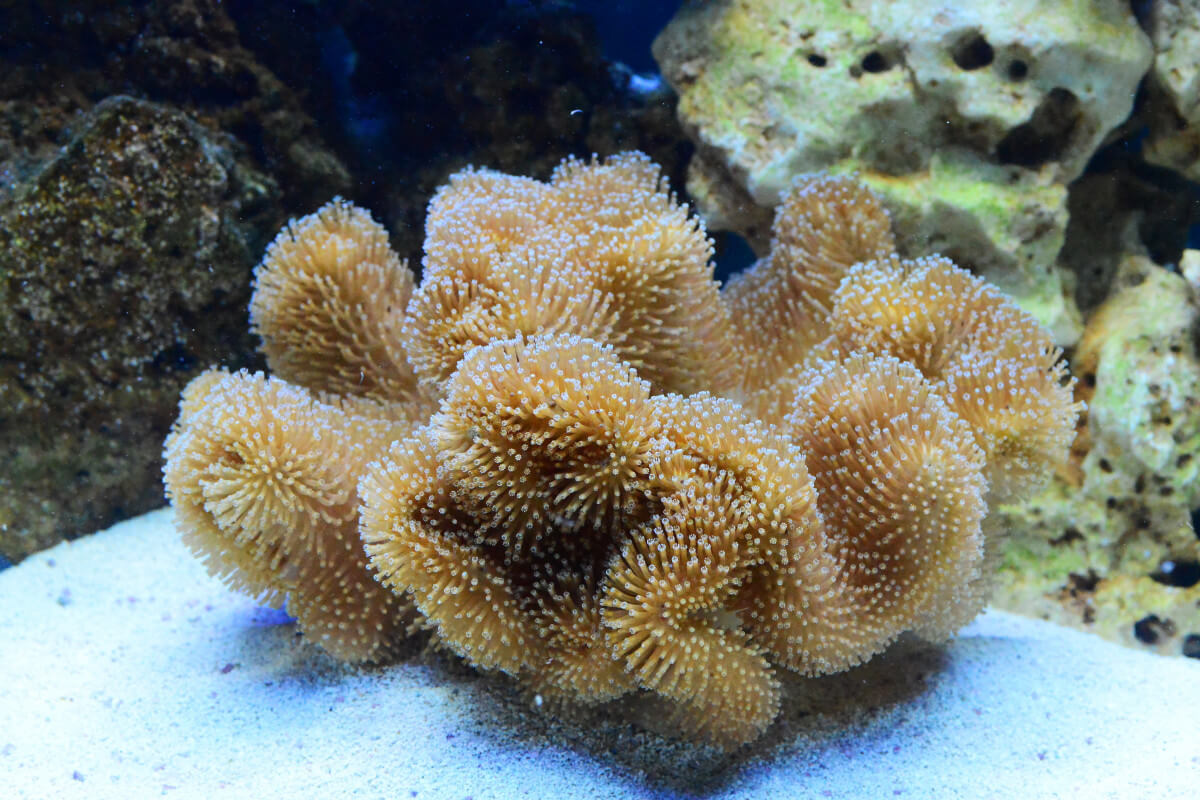
Size
Leather corals that are well cared for can easily grow to reach 20 inches in length given enough time. Most hobbyists will purchase leather coral frags that are sold between 1-2 inches in size, and a large leather coral could be considered to be between 4 to 7 inches in size.
In the wild, leather corals can grow to be quite large, and single colonies of leather corals can grow to a whopping 10 feet across, but in the reef keeping hobby, these corals tend to be much smaller.
Growth Rate
Leather corals are slow growers, given an ideal environment, you can expect most leather coral species to grow an inch every 4 months.
In a nutrient-rich environment, with adequate lighting and direct feeding, you can achieve even faster growth rates, up to 1.5 inches per month.
Appearance & Types
While there are many different types of leather corals, some are certainly more popular than others. Leather corals that have bright neon coloration tend to be the most common, but other species are also sought after for their unique shapes.
If you’re considering adding a leather coral to your reef tank, you can’t go wrong with any of these eye-catching species.
ORA Neon Green Toadstool
One of the most popular types of leather corals are Toadstool corals (scientific name: Sarcophyton trocheliophorum) and the Neon Green Toadstool is one of the brightest in the hobby.
They’re not collecting from the wild, and come from ORA , a Florida-based aquaculture facility. Their bright green tentacles make them a favorite amongst hobbyists, and you can expect to pay a premium price. Neon Green Toadstools can run between $80-$120 for a 1-inch frag.
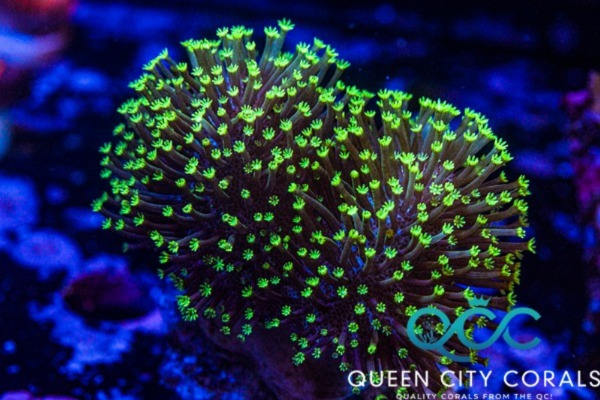
ORA Neon Green Sinularia
If Neon Green coloration is your thing, another attractive leather species is the Neon Green Sinularia. The Sinularia genus contains over 150 species, and this ORA-bred Neon Green variant is a popular option.
This coral has thick stalks, with an intense fluorescent green base. Similar to other leather corals, it’s an incredibly hardy species, and is relatively affordable, costing between $50-$70 for a small 1-2” frag.
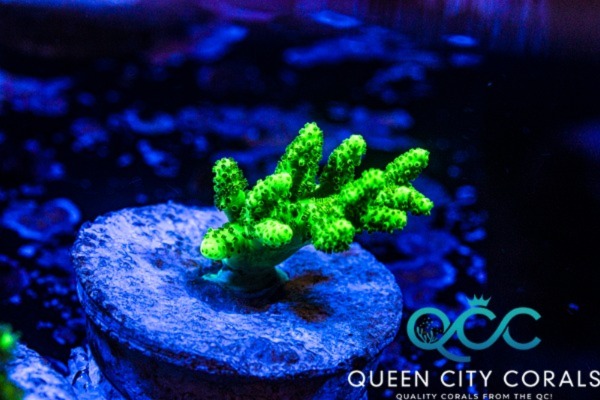
Yellow Fiji
Not every hobbyist is interested in the neon colors often seen in some of the hobby's most popular corals. If you’re looking for a more neutral color, you can’t go wrong with the Yellow Fiji leather coral (scientific name: Sarcophyton elegans)
This Sarcophyton coral makes an excellent aquarium centerpiece and is sure to catch the eye of any passerby. Its toadstool-shaped appearance comes with a price, hobbyists looking to get their hands on one can expect to pay between $150-$200 for a 3-4” frag.
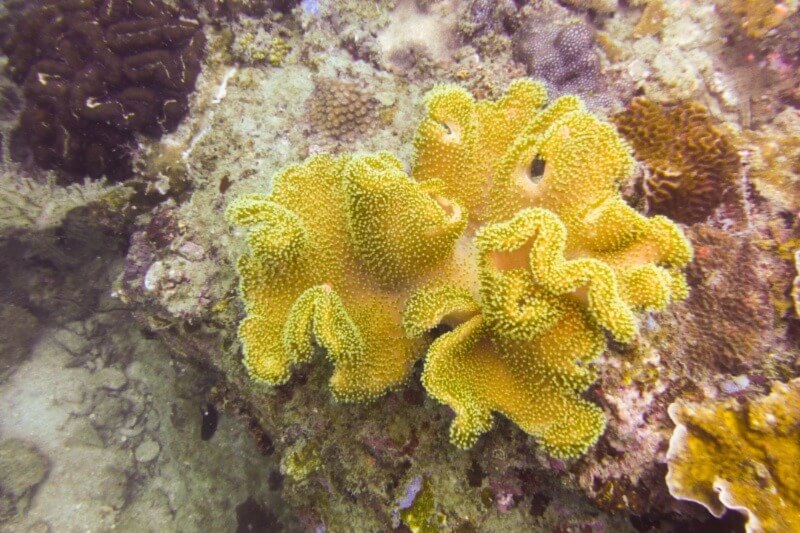
Elephant Ear
Next on our list of leather corals is the Elephant Ear Coral (scientific name: Sarcophyton trocheliophorum), this coral has a mushroom-like appearance, made up of a long stalk with a top known as a capitulum.
These corals can get quite large, easily reaching up to 20 inches in length. If you have an aquarium large enough to house one of these corals, be sure to jump at the opportunity if you find one for sale. These corals are hard to find but are relatively affordable considering most hobbyists don’t have a tank large enough to house one. Prices between $50-$150 are not unheard of for one of these species.
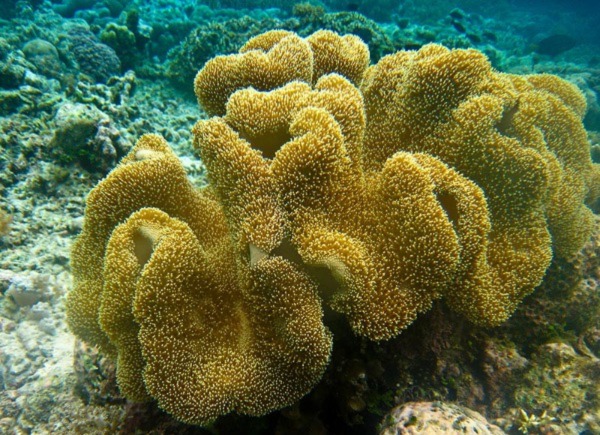
Dish-top
While most leather corals tend to be easy to keep, the Dish-top Leather Coral, also known as the Weeping Willow leather coral, (scientific name: Sarcophyton ehrenbergi) could certainly be considered one of the easiest. This coral can be found off the coasts of Taiwan, where it has unusually long polyps that can reach up to four inches in length.
What it lacks in fluorescence, it makes up for with its flowing polyps. This coral has a unique pinkish/brown coloration and has been making its way around the reef keeping hobby since the year 2000.
This coral is quite rare, a 3-4” frag can sell for about $150.
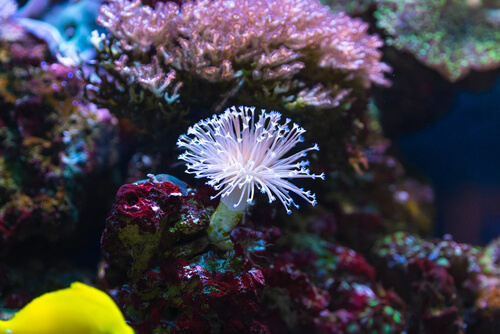
Devil's Hand
Many coral species make up the Lobophytum genus, all of which are frequently known as devil's hand leather corals. These corals live in shallow waters, throughout the Indo-Pacific, and are close relatives to the more common Sarcophyton genus.
Green, pink, tan, and yellow are the more common colors seen in these corals that are relatively easy to find for sale. They’re easy to care for, and are quite affordable, selling for about $50 for a 2-inch frag.
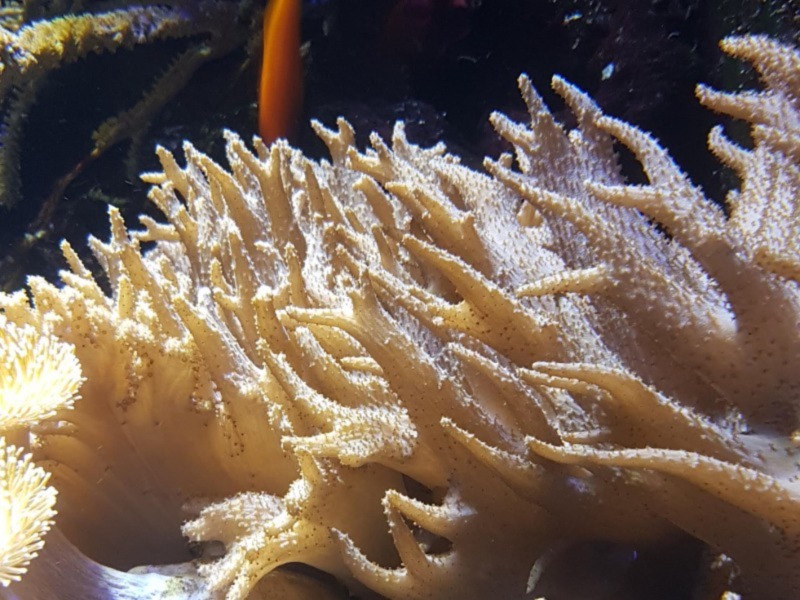
Leather Coral Care
If you're considering adding a leather coral to your collection, you'll be happy to know that they are among the easiest corals to care for. They are often recommended to beginner hobbyists, and for good reason - they are relatively low-maintenance and quite tolerant of most water conditions.
However, as a collector of these fascinating species, it's your responsibility to provide them with the best care possible. Therefore, it's important to be aware of certain considerations before making a purchase.
Tank Size
You'll need a tank that is at least 75 gallons in size for a leather coral, and a larger tank is even better as these corals can grow to be over 20 inches in width.
If you're planning on keeping the coral for a short amount of time and then selling or trading it, the size of the tank is less important, it's more important to factor in this coral's growth rate and how it will affect any neighboring corals.
Leather corals can grow quite large and it's not uncommon for new hobbyists to have to give up their leather corals that have outgrown their tanks. This process can be difficult as it can be hard to find another hobbyist willing to sacrifice a large tank to accommodate them.
Water Parameters
Leather corals are highly adaptable when it comes to lighting and water flow, but it’s still important that you provide pristine water conditions.
Aim for the following if you plan on keeping a leather coral (or any other coral for that matter.)
Nitrite: 0 ppm
Ammonia: 0 ppm
Nitrate: <10 ppm
pH: 8.2-8.4
Maintaining these conditions for the duration of your tank is key, as stability is one of the most important aspects of reef keeping.
Tank Setup
When planning an aquarium, it's crucial to set it up in a way that is beneficial to the inhabitants. Lighting, placement, and flow should always be considered when planning an aquarium, and this is no different whether or not you plan on keeping leather corals.
Placement
Leather corals should be placed at the bottom of the tank, where they should be glued to a small piece of rock that’s buried directly in the sandbed.
You can also place your leather coral on rock, but keep in mind that as they grow, they will shade the area directly underneath them, which could be problematic for other coral species you may be keeping.
These corals are also toxic, and will release toxins into the water column if they’re stressed or feel threatened, so be sure to keep enough space between neighboring corals (at least 8 inches), while accounting for growth rates.
Lighting
Aim for low to moderate lighting (between 100-200par) if you plan on keeping leather corals. If you plan on running high light, leather corals are capable of adapting to these conditions, just be sure to slowly acclimate and monitor them over a 3-4 week period.
If you notice signs of stress, such as bleaching , reduce light intensity, or re-position the coral to a more shaded area of the tank.
Flow
We recommend having moderate flow for leather corals. They’re not too picky when it comes to flow rate, since their flesh won’t tear from too strong of a current. Similar to their lighting requirements, they can adapt to different types of flow rates over a few weeks.
When it comes to flow direction, flow rates should be indirect, and random. A configurable powerhead makes this process simple.
When healthy, leather corals will shed a waxy layer, which they use to prevent the accumulation of algae and diatoms from growing on their flesh.
Feeding
You do not need to directly feed leather corals to ensure their success in a reef aquarium.
Leather corals, similar to chalice corals, have a symbiotic relationship with zooxanthellae, which are single-celled dinoflagellates that supply most of a leather coral’s nutritional needs.
However, if you want to turbocharge your leather coral’s growth rates, you can directly feed your leather corals twice a week by using a pipette and coral foods such as Red Sea Reef Energy Plus AB+ and Reef Roids .
Behavior
Leather Corals are some of the more peaceful species of coral, but they will release toxins when stressed. These toxins can be lethal to tank inhabitants and neighboring corals, so it’s important to mitigate the effect of these toxins by performing routine water changes. The toxicity can also be reduced by adding activated carbon to a media reactor .
In terms of movement, you’ll need a time-lapse camera to notice any growth and retraction of the coral’s polyps, but certain species, such as the tentacles of the weeping willow can create a unique sense of motion when provided enough flow.
Leather corals are also known to change shape over time, it can take many months for a small leather coral frag to develop the toadstool appearance often seen with some of the more popular Sarcophyton species. Be patient. After a few months have passed, you’ll begin to notice your coral changing shape.
Fragging
Fragging leather corals is relatively straightforward, but it is important to keep in mind that these corals release a toxin when cut, so it is best to remove them from your display tank before cutting. You can dip the mother colony and the frag in a coral treatment, such as Lugols Iodine Solution , to aid the healing process post-cutting.
When using a sharp razor or scissors, make as clean of a cut as possible. One of the nice parts about fragging leather corals is that you can cut the foot or the head of the coral, and the frag will still grow healthily.
After treating the frag, you can attach it to a frag plug, but the tricky part is that leather corals will cover themselves with a layer of slime that they excrete when stressed, making it difficult to mount the frag to a frag plug with epoxy or superglue. Instead, you can use a rubber band to attach the frag to a frag plug. Ensure that there is only enough tension from the rubberband so that the coral stays in place on the frag plug. Then, place the frag onto a frag rack. Over time, the leather coral will attach itself to the frag plug, and it can be removed from the frag rack and placed in a different location in your display tank, or prepared for shipment.
Tank Mates
Leather corals look fantastic in a tank made up exclusively of soft corals, but given enough space, they can do well with other coral species. Torches, Brain Corals, and Chalices are some of our favorites, but there are tons of interesting unique species that will pair well with your leather corals.
As far as livestock goes, you can’t go wrong with the following, but any reef-safe fish will do.
- Pink-Streaked Wrasse
- Saddleback Clownfish
- Blonde Naso Tang (requires at least a 180-gallon aquarium)
- Pink Skunk Clownfish
- Snowflake Clownfish
- Kole Yellow Eye Tang
- Cleaner Shrimp
LPS corals, such as Acanthastrea will also look great in an aquarium with leather corals.
Avoid non-reef-safe fish, such as Butterflyfish and Angelfish, as they are known to pick at and eat corals.
Conclusion
It's easy to see why leather corals are so popular in the reef-keeping hobby. They offer unique colorations that are different from the fluorescence colors often sought after by hobbyists, and as a result, allow for endless creativity when it comes to aquascaping. They are also relatively low-maintenance and easy to frag, making them an ideal option for beginner hobbyists.
Now that you have learned about the characteristics of leather corals, do you plan on adding one to your reef tank? Let us know by commenting below and be sure to check out our marketplace and community forum where you can connect with other reef keeping enthusiasts.
December's Giveaways on Light Fish








